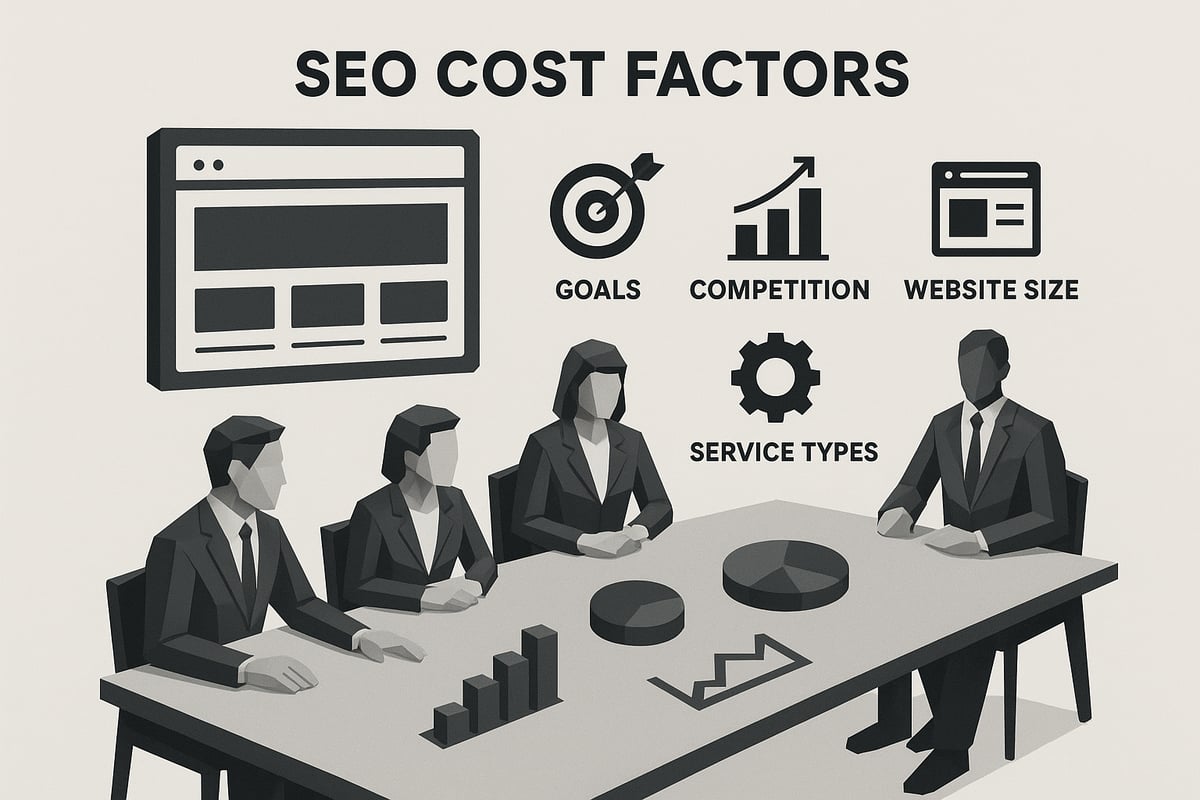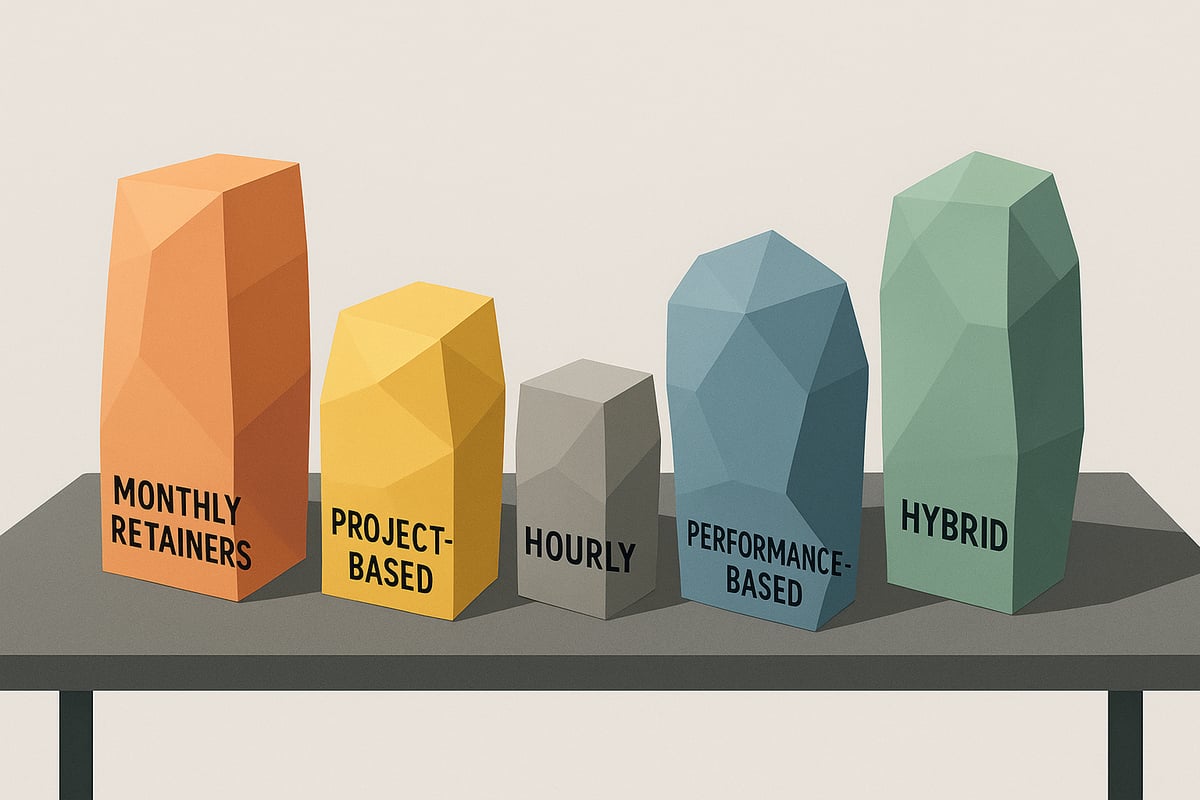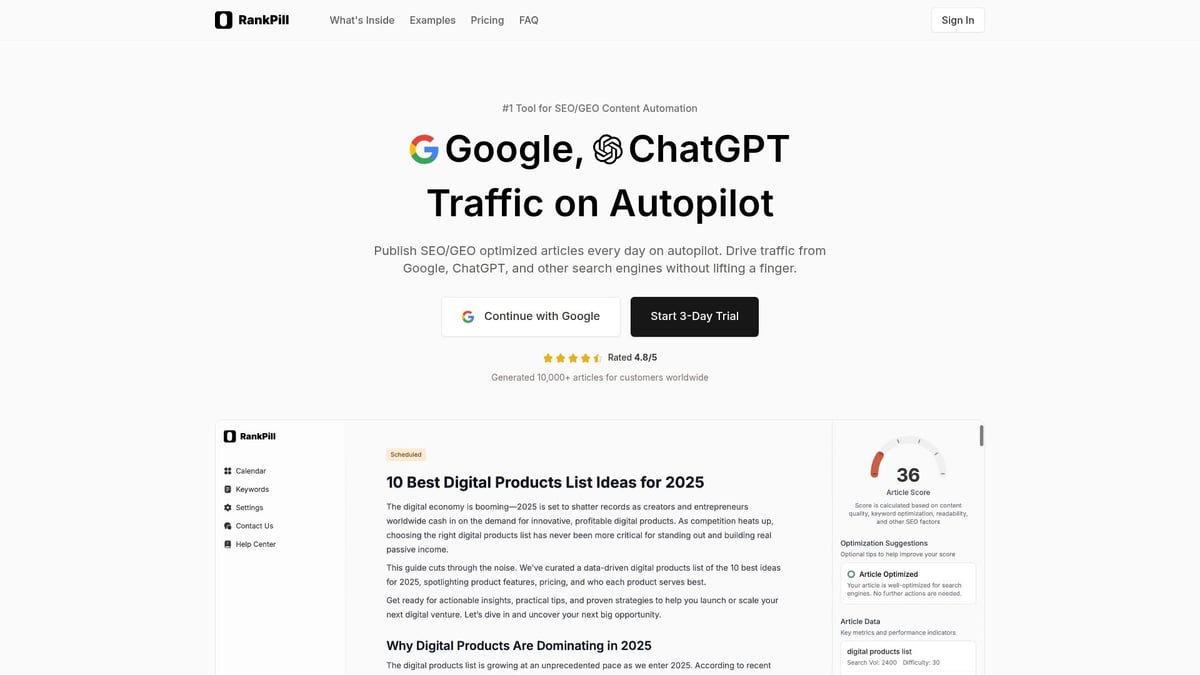How much should you really budget for SEO in 2025? The answer could make or break your digital growth. Many businesses struggle to understand seo costs, facing a confusing mix of price ranges and mixed promises from agencies. Recent industry surveys show frustration is common, especially when results don’t match investment.
Knowing what drives seo costs is essential to avoid common pitfalls and wasted budget. A well-planned approach can accelerate results and keep your marketing spend efficient.
Use this guide to set realistic expectations, avoid overspending, and maximize ROI. We will demystify seo costs in 2025, break down pricing models, and show you what influences pricing. You will also learn how to build a practical budget and get actionable tips for businesses of all sizes.
The Key Factors Influencing SEO Costs in 2025
Understanding what drives seo costs is essential for building a realistic SEO budget. In 2025, several core factors will determine how much businesses should invest. Each element below plays a distinct role in shaping your final spend, so let’s break them down.

Goals and Business Objectives
Your business goals are the foundation for determining seo costs. Whether you’re aiming to boost traffic, generate leads, increase sales, or raise brand awareness, each objective demands a different SEO approach.
For example, a local bakery may need only targeted local SEO, while a national e-commerce site requires a comprehensive strategy. The more ambitious your goals, the higher your investment will be.
Industry surveys show that aligning your SEO spend with key business KPIs leads to more measurable results. Each unique goal impacts the complexity, timeline, and scope of work, directly influencing your seo costs.
Competition and Industry Landscape
The level of competition in your industry has a major impact on seo costs. Highly competitive sectors like legal or finance require more resources, advanced tactics, and ongoing investment.
Keyword difficulty and market saturation drive costs up. For instance, ranking for “best credit cards” is far more challenging than ranking for “local bakery in Austin.”
Competitor benchmarks are useful. By assessing what top players spend, you can set a more realistic budget. In crowded markets, expect higher seo costs to achieve and maintain visibility.
Website Scope and Baseline
The size and technical health of your website are crucial drivers of seo costs. An 8-page brochure site has different needs than a 1,000-page e-commerce platform.
New domains often need more upfront investment to build authority and fix foundational issues. In contrast, established sites may focus on ongoing optimization.
Large site migrations, technical overhauls, or penalty recoveries add significant project costs. Agencies often charge more for sites needing extensive foundational work, which can quickly increase your seo costs.
Service Type and Deliverables
The specific SEO services you need will shape your seo costs. Local SEO, e-commerce SEO, international SEO, and content marketing all come with unique pricing structures.
Deliverables like audits, link building, content creation, and technical fixes vary widely. Customized strategies typically cost more than fixed packages. For example, manual citation building is more resource-intensive than automated listing management.
To see a detailed breakdown of how service types influence pricing, check out this SEO pricing breakdown. Understanding deliverables ensures you invest in what your business truly needs.
Agency/Consultant Experience and Location
Who you hire can dramatically affect seo costs. Senior experts and top-tier agencies command higher rates but bring greater expertise and impact.
Geographic location matters too. US-based agencies often charge $100 to $200 per hour, while global providers may offer lower rates. However, paying for true expertise tends to yield better satisfaction and results.
Data shows businesses that invest more in experienced providers report higher ROI. Balancing budget with desired outcomes is key when evaluating seo costs.
SEO Pricing Models Explained
Choosing the right SEO pricing model is crucial for aligning your investment with your business goals and maximizing ROI. SEO costs can vary dramatically based on service structure, provider experience, and deliverables. Understanding the main pricing frameworks helps you avoid surprises and make informed decisions.

Monthly Retainers
Monthly retainers are the most popular SEO pricing model. Businesses pay a fixed monthly fee for a bundle of ongoing services, making budgeting for SEO costs predictable. Typical ranges are $1,000–$5,000 or more per month, with US averages falling between $2,501 and $5,000.
Retainers often include on-page optimization, content creation, link building, regular reporting, and monitoring. This setup is ideal for businesses needing comprehensive, long-term strategies. However, some agencies may bundle low-impact deliverables, so ensure your spend aligns with real outcomes.
Pros:
- Predictable seo costs and consistent support
- Suited for complex, content-heavy needs
- Agencies often bundle multiple services
Cons:
- Risk of paying for busywork if not monitored
- May feel inflexible for changing needs
According to SparkToro, 87% of agencies offer retainers, and satisfaction increases significantly when spending above $500 per month. For a deeper look at what to expect, see Monthly SEO services explained.
Project-Based Pricing
Project-based pricing is a one-time, fixed-fee arrangement for specific deliverables, making it easy to control seo costs for defined needs. Prices typically range from $1,000 to $8,000 or more, with US averages between $1,001 and $1,500.
Projects might include site audits, technical migrations, penalty recoveries, or content banks. The main advantage is clarity—both timeline and deliverables are set from the start. However, this model may not cover ongoing optimization or address future challenges.
Pros:
- Clear scope and deadline
- No ongoing commitment
- Control over seo costs for discrete needs
Cons:
- May not handle ongoing needs
- Unforeseen issues may require new agreements
Ahrefs reports that 44% of agencies offer project-based pricing, with most projects falling within the $1,001–$1,500 range.
Hourly Pricing
Hourly pricing lets you pay for SEO work as needed, which can keep seo costs manageable for small tasks or consulting. In the US, hourly rates commonly range from $100 to $200, while global rates often fall between $50 and $150.
This model works well for expert audits, troubleshooting, or strategy sessions. However, without tight scope control, costs can add up quickly.
Pros:
- Flexibility for ad hoc needs
- Ideal for small fixes or one-off advice
Cons:
- Difficult to predict total seo costs
- Not ideal for ongoing campaigns
Ahrefs data shows that 88% of providers charge $150 per hour or less.
Performance-Based Pricing
Performance-based pricing ties payment directly to results, such as keyword rankings or traffic increases. This is the least common model, with only 15% of agencies offering it, according to SparkToro.
This setup appeals to risk-averse clients, as seo costs are linked to clear outcomes. However, it can incentivize shortcuts or focus on vanity metrics rather than business value.
Pros:
- Pay only for measurable results
- Aligns interests for short-term gains
Cons:
- Risk of black-hat tactics
- May overlook long-term strategy
Use caution with performance-based models, as misaligned incentives can harm your site in the long run.
Hybrid and Custom Models
Many providers now offer hybrid models, blending retainers with project-based, hourly, or performance pricing. This approach allows for a more tailored fit and can optimize seo costs as your business needs evolve.
For example, you might start with a technical audit (project-based), then move into a monthly retainer for ongoing work. Hybrid models offer flexibility and scalability, especially for growing businesses.
Pros:
- Custom fit for unique needs
- Scalable as priorities shift
Cons:
- Can be complex to manage
- Requires clear communication
Ahrefs notes that 40% of agencies support multiple pricing models.
Pricing Model Selection: What’s Right for Your Business?
Selecting the right SEO pricing model depends on your business size, goals, internal resources, and need for flexibility. Small or local businesses may prefer project-based or hourly models to control seo costs, while larger enterprises benefit from retainers that support ongoing initiatives.
Consider the complexity of your needs, your desired outcomes, and how much hands-on management you want. For example, a local business may only need a one-time setup, while a national brand requires continuous campaigns. Competitors often advise against locking into retainers unless your needs are ongoing and multifaceted.
Compare the main models below:
| Model | Typical Use Case | Price Range | Pros | Cons |
|---|---|---|---|---|
| Monthly Retainer | Ongoing, complex needs | $1,000–$5,000+/month | Predictable, comprehensive | Inflexible, risk of busywork |
| Project-Based | Defined, one-off projects | $1,000–$8,000+ | Clear scope, no commitment | No ongoing support |
| Hourly | Small tasks, consulting | $100–$200/hr (US) | Flexible, pay as you go | Costs can add up |
| Performance-Based | Results-driven campaigns | Varies | Pay for outcomes | Can incentivize shortcuts |
| Hybrid/Custom | Evolving needs | Mixed | Tailored, scalable | Complex to manage |
Understanding and selecting the right model will ensure your seo costs are well spent and aligned with your growth strategy.
SEO Costs by Service Type and Deliverable
Understanding seo costs starts with recognizing the wide range of service types and deliverables available. Each business will require a unique mix of these services, and the investment will depend on both the type and depth of work needed. For a comprehensive breakdown of common services and what drives cost differences, see this helpful guide on Types of SEO services.

Local SEO
Local SEO is essential for businesses aiming to attract customers from specific geographic areas. Typical services include setting up and optimizing Google Business Profiles, building citations, acquiring local links, and managing reviews.
Pricing for local SEO varies depending on the competitiveness of your area and the scope of work. Most monthly packages range from $750 to $3,000, with manual citation building costing between $200 and $600. Automated listing management tools like Moz Local or Yext charge $14 to $50 per location each month.
For plumbers, dentists, and other service providers, seo costs here focus on visibility in local search results and Google Maps. Bundled packages for Local Pack plus organic SEO are common, typically at $999 to $3,000 per month.
Link Building
Link building remains a significant driver of seo costs, especially in competitive industries. The price can vary drastically depending on the quality and method of link acquisition. Purchased links, which are not recommended due to risk, may cost $50 to $200 each.
Manual outreach and content-driven link building are more reputable and often range from $150 to $1,500 per link. For larger campaigns, monthly budgets can run from $5,000 to $20,000. Agencies may create linkable assets and conduct outreach to build authority safely.
Quality always outweighs quantity in link building. Poor quality links can result in penalties, increasing future seo costs and risking your search visibility.
Content Marketing and SEO Content Creation
Investing in content marketing is a core element of modern seo costs. This includes creating blog posts, landing pages, content hubs, and thought leadership articles. Small and mid-sized businesses typically spend between $1,500 and $10,000 per month for these services, while enterprise-level organizations can see costs from $6,000 to $60,000 or more.
Typical deliverables cover keyword research, content planning, writing, and on-page optimization. For example, B2B tech companies often build extensive content banks to target a variety of search intents. Content services are frequently bundled with broader SEO retainers, further impacting total seo costs.
Technical SEO and Site Audits
Technical SEO addresses the underlying structure and health of your website. Services include site architecture reviews, crawlability improvements, speed optimization, and schema markup. A thorough technical audit can cost between $1,000 and $5,000 depending on website size and complexity.
Ongoing technical support may be wrapped into monthly retainers, but large projects like site migrations or penalty recovery will raise seo costs significantly. Many agencies recommend starting with a technical audit to prioritize fixes before launching broader SEO campaigns.
E-commerce and Enterprise SEO
E-commerce and enterprise SEO require a higher level of investment due to the size and complexity of these websites. Monthly seo costs for these projects typically range from $5,000 to $50,000 or more. Services often include product and category optimization, large-scale technical fixes, and international SEO strategies.
For example, a Shopify store with thousands of products will need ongoing optimization and robust technical support. Enterprise SEO usually bundles multiple service types, including content, technical, and link building, to ensure consistent results at scale.
Add-On Services: Reporting, Analytics, and Consulting
Add-on services such as reporting, analytics setup, and strategic consulting can influence overall seo costs. Some agencies include basic reporting in their packages, but in-depth analytics or custom dashboards may incur extra charges.
Businesses may also opt for quarterly strategy sessions or advanced data analysis, which can be billed hourly at $250 to $400 or project-based. These services provide valuable insights and help ensure your SEO investment delivers measurable results. Regular consultation and analytics reviews are key to refining your approach and controlling seo costs over time.
Common SEO Pricing Traps and How to Avoid Them
Understanding seo costs in 2025 means more than just looking at the price tag. Many businesses fall into common traps that drain budgets and deliver little value. By recognizing these pitfalls, you can make smarter decisions and ensure your seo costs work towards real business growth.
Overpriced Retainers with Low-Impact Deliverables
One of the most expensive traps in seo costs is paying for monthly retainers that provide little real optimization. Many agencies package basic reports, thin blog posts, or constant monitoring under high-priced contracts.
For example, some businesses pay $1,000 to $5,000 each month but receive only dashboards or generic updates with no actionable improvements. These retainers can quickly drain resources without boosting rankings or traffic.
High-value retainers should deliver strategic work, not just routine reporting. To understand fair pricing and compare various models, see this SEO pricing models comparison.
Bargain SEO Packages and Checklist Services
Low-cost offerings are another seo costs trap. Packages priced at $20 to $50 per hour often cover only surface-level tasks, such as basic H1 fixes or title tag updates.
While these services might seem appealing, they rarely include the expertise needed for real results. Inexperienced providers may follow simple checklists, missing the strategic insight that drives rankings and ROI.
Businesses that choose bargain seo costs often find themselves investing more later to fix ineffective work. True SEO requires a tailored approach, not just ticking boxes.
Niche and One-Size-Fits-All Packages
Industry-specific packages promise quick wins, but these generic solutions are a hidden seo costs risk. For example, "SEO for dentists" or "SEO for lawyers" packages might use recycled content, low-quality backlinks, or templated reports.
Such one-size-fits-all approaches often ignore your unique business goals, audience, and competitive landscape. This lack of customization can result in wasted budget and missed opportunities.
To get the most from your seo costs, insist on a strategy that is tailored to your market and objectives.
Audit Overload and Unnecessary Upsells
Some businesses spend their seo costs on repeated audits or add-ons that deliver little actionable value. Web designers may offer multiple audits, but these often export errors from tools without providing fixes.
Paying for constant diagnostics rather than real implementation is a common pitfall. Instead, prioritize investing in work that directly addresses issues and improves performance.
Focus your seo costs on impactful changes, not just reports or unnecessary upsells, to see measurable results.
How to Build an Effective SEO Budget for 2025 (Step by Step)
Building a smart SEO budget for 2025 means more than just picking a number. You need a methodical approach that aligns with your business goals, challenges, and resources. Let’s break down the process into six actionable steps to help you take control of your seo costs and set yourself up for measurable results.
Step 1: Assess Your Current Situation
Start with a thorough evaluation of your website’s health and digital presence. Use reliable SEO tools to check technical performance, content quality, authority, and your local visibility.
Make a simple checklist:
- Technical health: Are there crawl errors or speed issues?
- Content: Is your site missing key pages or topics?
- Authority: How strong are your backlinks?
- Local presence: Do you appear in local searches?
Knowing where you stand is essential for understanding future seo costs. An upfront audit, whether self-initiated or expert-led, can prevent wasted spend by revealing your most urgent needs. Addressing foundational issues first often leads to more efficient investments down the line.
Step 2: Define Clear SEO Goals and KPIs
Set specific, measurable objectives for your SEO. Do you want to increase traffic, generate more leads, boost sales, or raise brand awareness? Each goal shapes your strategy and impacts seo costs.
For example, a local café aiming for the top three spots in Google Maps will need a different approach than a national retailer targeting e-commerce growth. Define KPIs tied to business outcomes, such as organic traffic, conversion rates, or keyword rankings.
When your goals are clear, you can identify which services to prioritize and budget accordingly. This step ensures your seo costs translate into real, trackable results rather than vague promises.
Step 3: Understand Your Competitive Landscape
Analyze your competitors’ online presence and estimate their seo costs. Use tools to research their keyword rankings, backlink profiles, and content strategies. Identify the top players in your niche and compare their strengths and weaknesses to your own.
Ask yourself:
- How saturated is your market?
- Are your target keywords highly competitive?
- What is the estimated spend of top-ranking competitors?
The more competitive your industry, the higher your seo costs will likely be. Understanding the landscape helps you benchmark your investment and set realistic expectations for both budget and timelines.
Step 4: Choose the Right Pricing Model and Service Mix
Not every business needs the same SEO approach. Consider which pricing model—retainer, project-based, hourly, or hybrid—matches your needs and resources. Select your service mix based on your goals: technical fixes, content creation, local SEO, or link building.
For small businesses, a combination of one-time audits and ongoing content may be ideal. If you’re unsure where to start, SEO for small businesses offers additional guidance on matching services to your growth stage.
Choosing the right model and mix is crucial for controlling seo costs and getting value for every dollar spent.
Step 5: Allocate and Prioritize Your Budget
Distribute your seo costs according to high-impact activities. Use your earlier assessment to determine where funds will have the greatest effect—technical upgrades, authority building, or content development.
A sample allocation table:
| Area | % of Budget |
|---|---|
| Technical SEO | 30% |
| Content Creation | 40% |
| Link Building | 20% |
| Reporting/Analysis | 10% |
Plan for both initial investments and ongoing maintenance. Prioritize urgent fixes first, then shift to monthly content or link strategies. For deeper insights on distribution, review SEO budget allocation strategies to ensure your spend aligns with industry best practices.
Step 6: Monitor, Measure, and Adjust
SEO is not static. Track your key metrics with analytics tools to see how your seo costs are performing against your KPIs. Review results regularly—monthly or quarterly—and be ready to reallocate funds to what works best.
If a particular service or channel underperforms, reduce spending there and boost investment in high-performing areas. This ongoing optimization guarantees your seo costs remain efficient and impactful, supporting your business as it evolves.
Maximizing ROI: Smart SEO Spending Strategies for 2025
Achieving the highest return on your seo costs in 2025 is about more than just spending more. It requires a strategic, informed approach that balances expertise, technology, and ongoing evaluation. Below, we break down the most effective tactics for making every dollar count.
Focus on Expertise Over Volume
Investing in experienced professionals can dramatically improve the efficiency of your seo costs. Instead of paying for bulk tasks, focus on hiring senior-level experts who deliver strategic insights and high-impact recommendations.
For SaaS companies and other competitive sectors, allocating budget towards expertise rather than volume often leads to better outcomes. For a deeper analysis of how spending correlates with results in specialized industries, see this guide on SEO investment for SaaS companies.
A single expert consultation can outperform months of generic work. Prioritize quality over quantity at every stage.
Prioritize High-Leverage Activities
Direct your seo costs to areas that deliver the greatest business value. High-leverage activities include technical site fixes, building authority with quality backlinks, and developing cornerstone content hubs.
Not all SEO tasks are created equal. For example, resolving a crawl issue can boost your entire site’s visibility, while publishing thin blog posts may yield little benefit. To understand which actions matter most, review the latest SEO ranking factors 2025.
Regularly re-evaluate your strategy to ensure your budget is fueling impactful growth.
Avoid Common Traps: Busywork and Vanity Metrics
It is easy to let seo costs slip into low-value tasks. Many businesses overspend on activities that do not move the needle, such as excessive reporting or producing content that does not attract qualified traffic.
Avoid paying for dashboards that lack actionable insights or for blogs that never rank. Focus your investment on deliverables that directly impact your key performance indicators.
By continually questioning the value of each activity, you can ensure your spend drives measurable results rather than just busywork.
Leverage Automation and Technology (When Appropriate)
Modern SEO tools can help you stretch your seo costs further. Automation platforms streamline repetitive tasks like keyword research, reporting, and content scheduling, freeing up resources for strategy and creativity.
For local SEO, automated listing management can save time and reduce errors. However, remember that technology complements, rather than replaces, human expertise.
Balance automation with thoughtful oversight to maximize efficiency without sacrificing quality or compliance.
AI-Powered Content Automation: The Role of RankPill
For businesses aiming to scale content production while controlling seo costs, AI-powered platforms such as RankPill offer a robust solution. RankPill automates keyword research, content planning, daily article creation, and even auto-publishing.

Its features support multi-language SEO, internal linking, and real-time optimization, making it ideal for SMBs, agencies, and e-commerce sites seeking organic growth. By streamlining workflows, companies can achieve rapid traffic gains without hiring large teams or expensive agencies.
Reports from users highlight both traffic increases and significant cost savings through automation with RankPill.
Know When to Bring in Experts vs. DIY
Assess which aspects of SEO can be managed internally and which require outside specialists. Routine updates or content uploads can often be handled in-house, minimizing seo costs.
However, for technical audits, advanced strategy, or troubleshooting, bringing in an expert can prevent costly mistakes and accelerate results. Many businesses find a hybrid model—combining internal resources with periodic expert input—yields the best ROI.
Having clarity on when to outsource helps avoid unnecessary spend and ensures expertise is applied where it matters most.
Regularly Review and Optimize Your SEO Investment
Continuous optimization is key to maximizing your seo costs. Monitor performance closely against your goals, using analytics to identify what is working and what is not.
Reallocate budget from underperforming channels to those delivering strong results. For example, as your site’s authority grows, you may shift funds from link building to content expansion.
Regular reviews keep your strategy agile and ensure that every dollar spent contributes to your long-term growth.
Now that you have a clear understanding of what drives SEO costs in 2025 and how to set a budget that matches your business goals, it’s time to take action. If you want to streamline your SEO strategy and maximize your investment, using an AI-powered platform like RankPill can make a real difference. You can automate content creation, stay ahead of competitors with smart keyword targeting, and keep your publishing consistent—all while keeping costs predictable. Ready to simplify your SEO journey and boost your organic growth?
Get Started